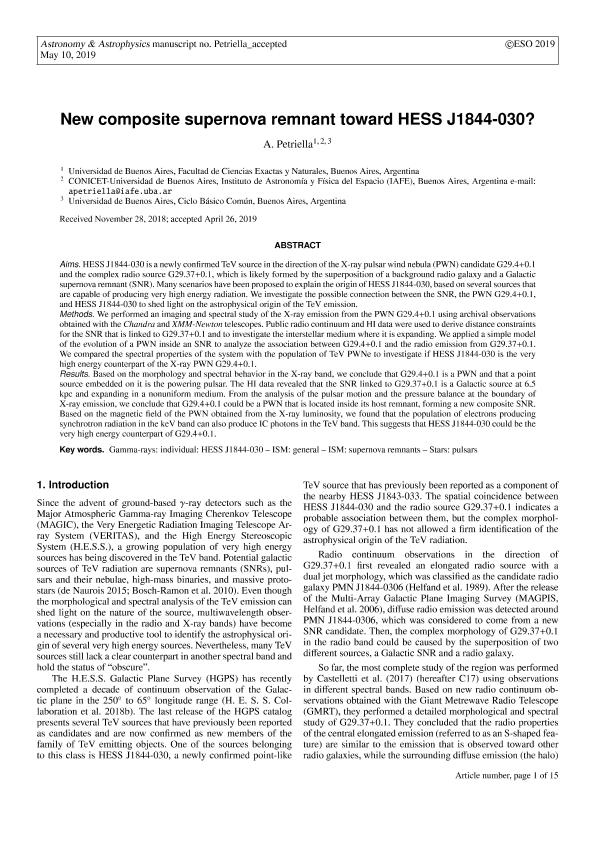Mostrar el registro sencillo del ítem
dc.contributor.author
Petriella, Alberto

dc.date.available
2023-08-23T14:03:41Z
dc.date.issued
2019-06
dc.identifier.citation
Petriella, Alberto; New composite supernova remnant toward HESS J1844-030?; EDP Sciences; Astronomy and Astrophysics; 626; A65; 6-2019; 1-15
dc.identifier.issn
0004-6361
dc.identifier.uri
http://hdl.handle.net/11336/209058
dc.description.abstract
Aims. HESS J1844-030 is a newly confirmed TeV source in the direction of the X-ray pulsar wind nebula (PWN) candidate G29.4+0.1 and the complex radio source G29.37+0.1, which is likely formed by the superposition of a background radio galaxy and a Galactic supernova remnant (SNR). Many scenarios have been proposed to explain the origin of HESS J1844-030, based on several sources that are capable of producing very high energy radiation. We investigate the possible connection between the SNR, the PWN G29.4+0.1, and HESS J1844-030 to shed light on the astrophysical origin of the TeV emission. Methods. We performed an imaging and spectral study of the X-ray emission from the PWN G29.4+0.1 using archival observations obtained with the Chandra and XMM-Newton telescopes. Public radio continuum and HI data were used to derive distance constraints for the SNR that is linked to G29.37+0.1 and to investigate the interstellar medium where it is expanding. We applied a simple model of the evolution of a PWN inside an SNR to analyze the association between G29.4+0.1 and the radio emission from G29.37+0.1. We compared the spectral properties of the system with the population of TeV PWNe to investigate if HESS J1844-030 is the very high energy counterpart of the X-ray PWN G29.4+0.1. Results. Based on the morphology and spectral behavior in the X-ray band, we conclude that G29.4+0.1 is a PWN and that a point source embedded on it is the powering pulsar. The HI data revealed that the SNR linked to G29.37+0.1 is a Galactic source at 6.5 kpc and expanding in a nonuniform medium. From the analysis of the pulsar motion and the pressure balance at the boundary of X-ray emission, we conclude that G29.4+0.1 could be a PWN that is located inside its host remnant, forming a new composite SNR. Based on the magnetic field of the PWN obtained from the X-ray luminosity, we found that the population of electrons producing synchrotron radiation in the keV band can also produce IC photons in the TeV band. This suggests that HESS J1844-030 could be the very high energy counterpart of G29.4+0.1.
dc.format
application/pdf
dc.language.iso
eng
dc.publisher
EDP Sciences

dc.rights
info:eu-repo/semantics/openAccess
dc.rights.uri
https://creativecommons.org/licenses/by-nc-sa/2.5/ar/
dc.subject
GAMMA RAYS: GENERAL
dc.subject
ISM: GENERAL
dc.subject
ISM: SUPERNOVA REMNANTS
dc.subject
PULSARS: GENERAL
dc.subject.classification
Astronomía

dc.subject.classification
Ciencias Físicas

dc.subject.classification
CIENCIAS NATURALES Y EXACTAS

dc.title
New composite supernova remnant toward HESS J1844-030?
dc.type
info:eu-repo/semantics/article
dc.type
info:ar-repo/semantics/artículo
dc.type
info:eu-repo/semantics/publishedVersion
dc.date.updated
2019-12-11T20:13:36Z
dc.journal.volume
626
dc.journal.number
A65
dc.journal.pagination
1-15
dc.journal.pais
Francia

dc.journal.ciudad
París
dc.description.fil
Fil: Petriella, Alberto. Consejo Nacional de Investigaciónes Científicas y Técnicas. Oficina de Coordinación Administrativa Ciudad Universitaria. Instituto de Astronomía y Física del Espacio. - Universidad de Buenos Aires. Facultad de Ciencias Exactas y Naturales. Instituto de Astronomía y Física del Espacio; Argentina. Universidad de Buenos Aires. Ciclo Básico Común; Argentina. Universidad de Buenos Aires. Facultad de Ciencias Exactas y Naturales; Argentina
dc.journal.title
Astronomy and Astrophysics

dc.relation.alternativeid
info:eu-repo/semantics/altIdentifier/url/https://www.aanda.org/articles/aa/abs/2019/06/aa34734-18/aa34734-18.html
dc.relation.alternativeid
info:eu-repo/semantics/altIdentifier/doi/https://doi.org/10.1051/0004-6361/201834734
Archivos asociados
